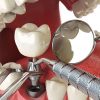Description
Infertility and IVF
What is Infertility?
Couples, with desire to have a child and despite unprotected sexual intercourse, if they are not able to conceive they start asking themselves whether if they are infertile. Women, under the age of 35 infertility can be diagnosed if pregnancy is not achieved despite one year of unprotected sexual activity. Women over the age of 35, the diagnosis is made after six months of unprotected sexual activity. If pregnancy is not achieved despite the couple’s best efforts, it is recommended to consult a specialist without losing any more time.
The first thing to do for couples trying to have a child should be to evaluate their general health. It is essential to determine the factors preventing fertility. Information on the subject and awareness increase the chance of becoming pregnant both by natural means and via assisted reproduction techniques.
What are the Causes of Infertility?
While 45% of infertility cases are due to male-related factors, another 45% are due to female-related factors. The remaining 10% consist of unexplained infertility cases.
Male infertility may have many causes. Genetic problems, birth defects, hormonal causes, chemical factors, infectious diseases, azoospermia, varicocele, and surgical operations are the leading causes of male infertility.
The causes of infertility related to women are as follows: ovulation disorders, polycystic ovary syndrome, damaged or blocked tubes, endometrioma, advanced age, cervical problems and vaginismus.
What are the Symptoms of Infertility?
Irregular menstruation is often a symptom of female infertility. If the length of your menstrual cycle is under 21 days or over 35 days, there might be an ovulation problem, which in turn might cause infertility.
Male infertility usually does not show any symptoms. A burning sensation or a discharge when urinating can be a form of prediagnosis. However, a definite diagnosis requires a spermogram (semen analysis). Performed after two to seven days of sexual abstinence, the spermogram provides information about sperm count, motility, and morphology. A treatment plan is created in accordance with the test results.
How is Infertility Treated?
Couples wishing to start treatment in order to have a baby should consult an IVF centre. When choosing a centre, it is essential to consider the success rates of the centre as well as the experience of its doctors. If you choose Bahçeci IVF Centre for treatment, one of our doctors will conduct a preliminary consultation with you, and then you will immediately start the necessary examinations. The results of the tests performed are evaluated. In our centre, the problems of every couple are evaluated from different perspectives and “personalised” treatment programs are planned.
As Bahçeci IVF Centre, we have 24 years of experience and expertise, and with success rates above European standards, we have helped in the birth of over 70,000 healthy IVF babies. For more information about the treatment of infertility, fill in our contact form and we will call you as soon as possible.
Our methods for the treatment of infertility are as follows:
Freeze-All IVF
Intra-Uterine Insemination (IUI)
Microinjection (ICSI)
Embryo Freezing
Sperm Freezing
Egg Freezing
EMBRACE Test is Applied For the First Time in Turkey at Bahçeci!
Simultaneously with the worlds leading IVF centres, Bahçeci IVF applies the EMBRACE test for the first time in Turkey with that chance of success is increased. EMBRACE test enables us to choose the healthiest embryos genetically without needing biopsy procedure.
What is EMBRACE Test?
EMBRACE test allows us to analyse the fluid geneticallyt that the embryo develops, with that we can have an estimate chance of succesfull pregnancy.
What are the Benefits of EMBRACE Test?
For the IVF practices, when choosing the embryo that can form pregnancy we rely on the microscopic analyses of the shape of the embryo as the most important criteria. However, even the best shaped embryo can have chromosomal disorder. To be able to diagnose a chromosomal disorder we take biopsy from the embryo for genetic analyses.
Today, with the PGT-A (Preimplantation Genetical Analyses) technology, we can check the chromosal structure of the embryo before we complete the embryo transfer to the uterus. However for this procedure, we must take a sample cell from the embryo via biopsy. To be able to complete te biopsy taking procedure, clinic must have experienced staff and high technology. Even with the state-of-art Technologies there is a small risk of damaging the embryo. Especially for patients whom can have only low number of embryos deciding on having PGT-A procedure is a though decision.
In the very basics EMBRACE test is taking a sample from the fluid where the embryo develops, we can analyse the genetics of this fluid with NGS technology, in that way we do not have to take a biopsy sample from the embryo and this procedure does not harm the embryo in anyway. Developped embryos can be analysed with EMBRACE test and we can choose the embryo with the highest chance of adherecing to the uterus to form pregnancy in the first treatment. Therefore many patients may not have the second treatment, thanks to EMBRACE test.
Who Can Have EMBRACE Test?
• Suitable applicants for PGT-A applications
• Women over the age of 38 with an increased risk of chromosomal disorders in their embryos
• Couples who have had recurrent IVF failures or miscarriages
• Couples who do not want to have embryo biopsy for different reasons
• Couples who want to have the highest chance of pregnancy in the first application of their treatment
• Couples who do not want to take the risk of multiple pregnancy and therefore want a single embryo transfer
EMBRACE test is used for “foresight” and “prioritization”. Results of this test is used to increase the chance of pregnancy. It cannot be replaced with the final chromosome analyses of the embryo.
Method Increasing the Chance of Success in IVF: Smart PGT
The Smart PGT method is the most advanced form of the NGS test, which allows us to conduct detailed genetic examination of embryos. The Smart PGT method provides the opportunity to select the embryo with the highest adherence potential by using artificial intelligence in the analysis of the results and increases the chance of pregnancy.
Smart PGT used by the world’s leading IVF centers PGT was first introduced in Bahçeci in Turkey.
What is the Difference between PGT and Smart PGT?
In order to define what the Smart PGT method is, first of all it is necessary to mention what PGT is.
PGT is the process of examining the chromosome number and structure of the embryos obtained in IVF treatment before they are transferred to the mother’s womb. With these tests, possible chromosomal defects in the embryos can be detected before the embryos is transferred to the uterus. PGT is a preferred as it is increases the chance of pregnancy and healthy birth especially in elderly women, women with recurrent treatment failures or recurrent miscarriages.
The Smart PGT method is an advanced version of the standard PGT. Smart PGT method uses a system where artificial intelligence is involved. Thus, embryos can be evaluated in more respects and the healthies one can be determined. The world’s few centers use the Smart PGT method, which increases the chances of healthy pregnancy.
How Can Artificial Intelligence Make Better Genetic Diagnosis?
PGT applications are generally considered as taking a certain number of cells from the embryos, examining them and identifying them as normal and abnormal according to the genetic structure of the embryo from which the cells are taken. However, there are many biological, technical or patient-related variables in order to make the correct diagnosis. Artificial intelligence collects all these variables in a common pool and evaluates the clinical success of tens of thousands of embryos (healthy birth, abortion, pregnancy failure, etc.) and in a way “educates“ itself. Thus, thanks to the algorithms created, the devices can detect the most accurate embryo by defining the results more clearly and accurately in the tests performed afterwards.
On Which Cases Smart PGT can be Used?
• Advanced maternal age
• In cases of recurrent miscarriages
• In cases of repeated failed IVF trials,
• Translocation or inversion carrier,
• Severe male infertility,
• Couples with a history of pregnancy with chromosomal abnormalities
• In consanguineous couples
What is the Cost of Smart PGT?
The Smart PGT application is a more advanced form of comprehensive chromosome screening in embryos called NGS, and is priced at the same price.
What is PRP Method?
PRP stands for Platelet-Rich Plasma, it is applied to the organ or tissue that requires treatment. This method has been applied for over 30 years, especially for orthopedy and plastic surgery for the treatment of muscle, skeleton, and bone damage to aide tissue repair.
In order to perform the PRP method, the blood taken from the patient is passed through certain procedures to obtain the platelet-rich plasma portion of the blood. The obtained plasma is applied to the tissue and the process is completed.
What is PRP Method in IVF?
It has been reported that PRP application can be used in two different ways in the fields on IVF: rejuvenation of ovarian tissue and the thickening of the uterine membrane (endometrium).
PRP application; the platelet rich plasma prepared by the individuals own blood is delivered into the ovary or uterus. If PRP is to be administered into the uterus, the patient is not anesthetized as the treatment is painless. If applied into the ovary the treatment is carried out under anaesthesia and again the patient does not feel any pain.
Are There People Who Conceived with PRP Method?
The first study on human rejuvenation with PRP was presented in 2016 in the Congress of the European Society of Human Reproductive Medicine and Embryology (ESHRE). In the study, it was reported that follicle development and mature egg production were achieved in 8 menopausal women (mean 1.5 mature egg cells) and obtained embryos were frozen.
Afterwards, there are studies that carried out similar practices, and there are several studies that indicate that the PRP application can be used to solve the mentioned problems, but there are controversial points in terms of content. Although the studies have resulted in pregnancy, there is not yet enough data to suggest that the PRP method provides a statistical success in these cases. Similarly, some improvements have been observed in the applications of PRP in the uterus of patients with uterine membrane problems, there is no satisfactory evidence in the literature that PRP is statistically successful.
Patients who have undergone many failed trials or diagnosed with early menopause and have a limited number of egg development have high hopes for PRP. However, as mentioned above it should be considered that there is not enough scientific data on this subject. It should be kept in mind at this stage that even if before the menopause, every woman who is able to respond to the conventional IVF treatments can have a certain chance of pregnancy. New medical studies need to be done in order to find out that applications such as PRP are clinically safe and increase success, and people in similar cases should be compared with and without PRP treatment to have accurate statistics.
What is the Risk of PRP?
With the current developments, there are 3 points that should be considered before deciding if PRP increases success in IVF treatments;
1) How secure is the technique? The PRP method has not yet proven success in the field of reproductive medicine, and we do not have enough data on the possible negative effects and safe use of the tissues and organs in which it is applied. Considering the application of ovarian rejuvenation, the PRP solution is considered to be an interventional procedure because it is given to the ovary with the help of a needle passing through the vagina as in the same egg collection (OPU). Like any interventional procedure, this procedure should be followed in order to see if there are any significant problems in terms of the health of the patien both during and after the procedure.
2) How is the expected ovarian rejuvenation or uterine thickening after PRP administration? Although a plasma rich in growth hormones is used, it is largely unknown as to whether PRP may play a role in the rejuvenation of the ovary as we do not know the factor or factors that may have a role on ovary rejuvenation.
3) How successful is the technique? Hormonal parameters that are taken from an extremely limited study group and eggs obtained after egg development are far from showing that the technique is widely applicable to the general patient group. In the case of thickening of the uterine membrane, the available data is not of a quality to show that the technique is a success. The answer to this question is therefore unclear currently.
Microinjection (ICSI)
What is Microinjection (ICSI)?
Microinjection is a method used in the treatment of male infertility. Patients suffering from low sperm count, low sperm motility or abnormal sperm morphology can have children thanks to this method.
Two different methods are used in IVF treatments. One of them is regular IVF, and the other one is microinjection. While the same While the same treatment stages are observed in both practices, the only difference lies in the fertilisation process. In regular IVF treatments, the egg and the sperm are left in the same medium and fertilisation occurs naturally. With microinjection, the healthiest, highest-quality sperm is carefully selected and injected inside the egg. This way, the chances of fertilisation are increased.
Who is Microinjection performed upon?
• On patients suffering from low sperm count or azoospermia
• On patients facing abnormal sperm morphology problems
• On patients who have had unsuccessful IVF attempts
• On patients undergoing Preimplantation genetic diagnosis (PGD)
• On patients suffering from unexplained infertility
What are the advantages of the microinjection technique?
Comparted to regular IVF, the microinjection technique provides higher chances of fertilisation. While achieving pregnancy remains difficult in patients suffering from low sperm count or quality, the microinjection technique offers the possibility of a healthy pregnancy.
In Vitro Fertilization (IVF)
What is IVF?
In vitro fertilization is a method of treatment used when couples cannot conceive despite unprotected regular intercourse. For couples to be assessed for infertility, pregnancy should not be achieved despite the following:
– Regular intercourse for a year, for females younger than 35 years of age
– Regular intercourse for six months, for females older than 35 years of age
An IVF treatment is a process that is performed as a result of professional teamwork. A successful outcome requires a professional team consisting of gynaecologists (gynaecologist and obstetricians), urologists, embryologists, nurses, and assistant staff.
How is an IVF treatment performed? What are its different stages?
The stages of IVF are as follows:
1. Stage: Medical Examination
On the first appointment, the causes of infertility are explained to the couple wishing to start treatment. Detailed information is given about the tests to be performed. The presence of both the man and the woman at the first visit is important. When coming to the clinic, the patient should bring the results of all the tests performed so far, a uterine X-ray if there is one, and reports of all previous surgical operations or infertility treatments. Moreover, if there are diseases such as heart disease or diabetes, all relevant information and reports should be brought as well.
There is no need to be on a certain day of your menstrual cycle for the first examination. This assessment can be done on any day. After a detailed gynaecological examination and ultrasonography, additional tests may be required if deemed necessary. When deemed necessary by the physician, examinations with the geneticist, urologist, embryologist, clinical psychologist, and dietician are planned. These experts then assess the general situation of the patient. The goal is first to establish the causes of infertility and to decide on the appropriate treatment for the patient; then, at the appropriate time, to provide the appropriate treatment.
2. Stage: Controlled Ovarian Stimulation
On the second or third day of her menstruation, the prospective mother comes in for an examination, and the doctor assesses the status of the ovaries via ultrasound imaging. Depending on the condition of the patient, the hormone levels on that day can also be looked at. According to the results, the physician prescribes a hormone treatment aiming to stimulate the ovaries of the patient and to produce multiple eggs. The relevant information is given to the patient. The hormone injections, which contain FSH and HMG, regularly stimulate the ovaries to promote the development of a large number of follicles (small sacs which are thought to contain egg cells).
The number of follicles developed directly affects the chances of success of the treatment. For this reason, the starting dose of the hormone injections depends on the age, weight, and previous treatments of the patient.
Follicular development is tracked through the oestrogen level in the blood and the size and count measurements of follicles via ultrasonography. By evaluating these data, the doses of the injections containing FSH and HMG are determined throughout the egg development stage. Following the hormone injections (8-10 days), a trigger injection is given when the largest follicle reaches 18-20 mm in size.
3. Stage: Egg Collection
Approximately 34-36 hours after the trigger injection, the eggs are harvested from the vaginal tract through a brief surgical procedure under general anaesthesia. Egg collection is a painless procedure performed under general anaesthesia. The collected eggs are taken into the laboratory and prepared for microinjection.
4. Stage: Fertilisation in the Laboratory
The eggs are assessed under the microscope in the laboratory. The most suitable ones are fertilised with selected sperms and monitored for embryo development. Two different methods are used for the fertilisation process. In regular IVF procedures, sperm and egg cells are placed in the same medium and fertilisation is achieved when the sperms reach the egg, as they would naturally do. With the microinjection method, the selected sperm cell is injected into the egg using microcannulae. The method to be used in the treatment is determined by evaluating the characteristics of the egg and sperm of the couples, along with their treatment history.
The fertilised eggs are placed in special devices called incubators, which are designed to mimic the uterine environment in the best possible way, and their development is monitored on a daily basis. The daily monitoring aims to help select the highest-quality embryo that is most likely to hold onto the uterus. As in distinguished high-tech laboratories, the Bahçeci laboratories also use a special incubator device that provides dynamic embryo imaging systems during embryo growth, follow-up and selection. With this device, also known as the embryoscope, the embryo can be monitored without any changes to its environment, and thus the selection of the embryo with the highest potential for pregnancy can be performed more accurately and more safely.
5. Stage: Embryo Transfer
This is the shortest but most important stage of the treatment. Failure to correctly transfer the selected embryo or embryos into the uterus can put the entire treatment at risk. For this reason, the experience and knowledge of the doctor performing the transfer are as important as the quality and choice of the embryo. The transfer procedure is usually painless, and anaesthesia is very rarely performed. Depending on the embryo count and development, age of the patient, previous attempts and many other parameters, the transfer is performed 2 to 6 days after OPU (egg collection).
The embryo, now at a certain degree of maturity, is transferred into the uterus with the help of a special catheter.
If there are remaining good quality embryos after the transfer, the couple may choose to freeze them for future use.
6. Stage: Medication treatment after the transfer
After the transfer, the patient is given a medication treatment to help the embryo hold onto the uterus.
7. Stage: Pregnancy Test
12 days after the transfer, a Beta-hCG blood test is performed to diagnose pregnancy.
How to choose an IVF Centre?
When choosing an IVF centre, it is essential to look at the experience of the centre, its technical equipment, and its pregnancy rates. Bahçeci Health Group is a huge family that proved itself with 23 years of experience and over 50,000 healthy IVF babies. We keep fulfilling the dreams of thousands of families with our expert doctors and embryologists, and our state-of-the-art embryology labs.
The CD56 Test
What is the CD56 Test?
The CD56 test is used to determine the density of “killer cells” within the uterus, which adversely affect the formation of pregnancy. Numerous molecular mechanisms are involved in the implantation of embryos to the uterus, both in spontaneous pregnancies and pregnancies resulting from IVF treatments. Within these mechanisms, it is of great importance that the immune system be appropriate for pregnancy.
In recent scientific studies, natural killer cells (NK cells) have been shown to play a very important role in the uterine implantation process. Whether the density of NK cells is above or below average in the inner layer of the uterus may adversely affect the implantation of embryos onto the uterus. One of the causes of pregnancy losses is a high density of NK cells in the inner layer of the uterus.
Who is the CD56 test recommended for?
The CD56 test can be performed on patients who want to have children, and who have had two or more miscarriages. In addition, it can be performed on patients who have not achieved pregnancy despite the transfer of three or more healthy embryos.
How is the CD56 Test Performed?
The CD56 test determines the ratio of natural killer cells (killer cells). It can be performed through blood sampling or uterine tissue sampling. However, since blood sampling may give inaccurate results, the preferred approach is to perform the test on uterine tissue.
After the ovulation period, an immunohistochemical assessment will be performed under anaesthesia by expert pathologists on the tissue sampled from the inner layer of the uterus between days 21 and 24.
Patients with high CD56 levels are administered immune system stabilizing treatments (such as intralipid injections) at appropriate intervals after the preparation for embryo transfer, and after appropriate conditions are provided.
Assisted Hatching
What is Assisted Hatching?
To help the embryos implant to the uterus, the “zona pellusida” surrounding the embryo is thinned or ruptured. This procedure is called assisted hatching.
Before fertilisation with the sperm, the egg cell is surrounded by a protective membrane. This membrane protects the embryo from the fertilization stage onwards and acts as a selective barrier between and the embryo and its external environment. On the 5th day of its development, the embryo’s journey that had begun in the fallopian tubes ends in the uterus. At this stage, the embryo needs to hold on to the most suitable place in the mother’s womb. To successfully achieve pregnancy, the “zona pellusida” needs to be ruptured so that the embryo can leave this membrane and implant to the uterus. Sometimes, the membrane surrounding the embryo may be thicker than expected. In these cases, the membrane is thinned through the assisted hatching procedure in order to help achieve pregnancy.
How is Assisted Hatching Performed?
Assisted hatching is usually performed on the day of the transfer. The process can be performed manually under the microscope, or the membrane can be thinned/ruptured using chemicals or a laser beam. Nowadays, the laser method is preferred because it is easier to perform, and because it does not damage the embryo.
Who is Assisted Hatching Recommended for?
Assisted hatching is recommended in the following cases:
• In patients over the age of 37,
• In FET (Frozen Embryo Transfer) cycles,
• In embryos intended to be transferred and whose membrane thickness is over 15 µm
• When necessary, in patients with recurrent implantation failures despite the transfer of healthy embryos
Assisted hatching is not an “on-demand” service, and it does not necessarily have to be performed on every embryo. Your doctor or the embryologists perform this method to selected embryos prior to embryo transfer when necessary, to increase the chance of pregnancy.
The Pooling Method
What is the Pooling Method?
In IVF treatments, the pooling method refers to two or more egg collection procedures (OPU) in which the collected eggs are frozen rather than immediately transferred. With this method, the pooled embryos are thawed together and monitored before being transferred into the natural or medically prepared uterus. For the method to be successful, the IVF centre to use it must have a very successful embryo freezing technique.
Does the Pooling Method Increase IVF Success?
Increasing the number of embryos to be transferred in women with low ovarian reserve effectively increases success. In addition, before the transfer, it is possible to monitor the pooled embryos together into the further development stages. Especially at the blastocyst stage (5th day), it is possible to select embryos which have the highest implantation potential and which are most likely to be genetically healthy.
Another advantage of the pooling method is that it can relatively lower the cost of the treatment. If a small number of eggs are collected during the first IVF cycle and the embryos are frozen without transfer, the cost of the second and subsequent egg collection procedures is reduced by 50%. This way, we increase our chances of achieving more successful results in the IVF treatment. Another advantage of this method is the increase in the number of embryos that can be biopsied for a Preimplantation Genetic Diagnosis (PGD), since testing them together means a decrease in the total cost of PGD.
Anxiety also increases in couples who have one or more failed attempts, which has an adverse effect on the subsequent treatment process. Many couples give up on the treatment because of these feelings of anxiety and depression. Yet, continuing the treatment would help many of them fulfil their parenting dreams. With the pooling method, it will be possible to relieve the feelings of anxiety of couples, as well as to achieve higher success rates for a lower price.
Who is the Pooling Method Recommended For?
The pooling method is mostly recommended to women with a low ovarian reserve, or to couples who have had failed attempts.
How is the Pooling Method performed?
If the expected number of healthy embryos could not be obtained for transfer following the egg collection procedure, embryo freezing is performed. The transfer is cancelled, and the patient undergoes another egg collection procedure. These steps can be repeated until a sufficient number of embryos are obtained. We talk about the pooling method when two or more egg collection procedures are performed prior to the transfer.
The Freeze-All Technique
What is the Freeze-All Technique?
In IVF treatments, it is essential to form and select the best-quality embryos in order to help our patients achieve their parenting dream as soon as possible. On the other hand, in a regular menstrual cycle, women produce only one egg every month, and generally over 50-70% of these eggs (depending on the age of the woman) cannot turn into a healthy embryo. In IVF treatments, patients are given high doses of ovary-stimulating injections, thus obtaining several eggs at once to select the ones that are most likely to result in pregnancy.
With this approach, many couples can produce a decent number of quality embryos and achieve healthy pregnancies. However, recent studies have shown that ovarian stimulation hormones/medications can adversely affect the inner layer of the uterus, thus reducing the chance of embryo implantation. In order to eliminate this adverse effect, we freeze the good-quality embryos for future use. We expect the uterine environment to return to normal within 1-2 months. Thus, this technique called the “freeze-all technique” allows the easier implantation of the embryo.
Who is the Freeze All technique recommended to?
This method, which was performed on a limited group of patients in the past, can now be performed on a much wider range of patients. The most important reasons for this are improved laboratory technologies and subsequent success in embryo freezing techniques. Earlier, performing this technique on patients with ovarian hyperstimulation syndrome (hypersensitivity to ovarian stimulation) was mandatory. Nowadays, we are able to comfortably use this technique on patients whose uterine environment may be disrupted due to the stimulation process. In some patients, the transfer of embryos can be easily postponed thanks to this technique, depending on social reasons.
Can the freeze all technique be performed at every clinic?
In order for the freeze all technique to be successful, the embryos should be frozen with extremely high success rates and thawed without any damage. In patients who use this technique at a centre which performs it appropriately and effectively, an increase of up to 5-15% in pregnancy rates can be observed compared to fresh embryo transfer patients. On the other hand, not only is it not possible to increase pregnancy rates in clinics where embryo freezing/thawing techniques are not performed successfully; but pregnancy rates using the freeze all technique are also lower than fresh embryo transfers. Therefore, the key to success in the freeze all technique is a state-of-the-art embryology laboratory that works efficiently within the clinic. In all our centres, we achieve successful results in freezing and thawing procedures in our embryology laboratories equipped with the latest technologies.
Egg Freezing
Egg freezing is a method that women who are considering having children in the future, but do not wish to give birth at the moment can resort to. Eggs collected from the ovary are frozen and stored for future use and can be thawed at any time.
One of the main obstacles to women having a child is the decline in ovarian reserve and ovarian quality that comes with age. Scientific studies and current treatment results show that the chance of having children is severely reduced for women over 40 years of age. Moreover, many women diagnosed with low ovarian reserve or early menopause experience this fear of not having children at an earlier age. Thanks to the egg freezing technique, women can freeze their eggs without losing their reproductive ability and have babies using these eggs in the future.
Who can egg freezing be performed on?
Until recently, egg freezing was not allowed in our country due to the legislation on assisted reproduction techniques. However, the revised regulation legally permits egg freezing under the following conditions, among others:
– when the person will be undergoing radiotherapy and/or chemotherapy, which are harmful to the reproductive cells, following a cancer diagnosis
– when a serious surgical operation will lead to the loss of reproductive functions
– when a single woman, who is not planning to get married anytime soon, is diagnosed with low ovarian reserve
Who is egg freezing recommended for?
• Patients who must undergo treatments damaging the egg cells, such as chemotherapy and radiotherapy
• Patients who will undergo a surgical operation (such as ovary removal) that will result in the loss of reproductive functions
• Women who have a family history of early menopause, or who have low ovarian reserve and have never been pregnant
• Women who are career-focused and do not wish to have babies before their 30s.
How is the egg freezing procedure performed?
For the egg freezing procedure to be performed, ovaries need to be stimulated with hormones. Treatment begins on the second or third day of the menstruation and lasts about 12-15 days. Collected eggs are frozen in the laboratory using a special method called vitrification and stored for later use.
Egg Freezing Procedure Step by Step:
Follow-up: The patient consulting our centre prior to treatment needs to visit our centre again on the second day of the menstruation, when the treatment begins. The patient is given ovary-stimulating hormones so as to produce more eggs than usual. During the follow-up period, the patient needs to come to our centre for an examination 3-5 times. During each visit, the patient is examined, hormone levels are checked, and drug doses are adjusted according to these findings.
Egg collection procedure: When the size of the follicle reaches the desired level, egg collection is carried out with a needle inserted through the vagina with ultrasound imaging. This procedure is painless under general anaesthesia and takes approximately 15 minutes. The patient is discharged within 2-3 hours and can continue her daily life.
Egg freezing procedure: The eggs are frozen through the vitrification technique, free of water crystals. Frozen eggs are stored in liquid nitrogen tanks at -196 degrees Celsius.
IVF Process: When pregnancy is desired, the eggs of the patient who consulted our centre are thawed and the IVF process begins.
The person undergoing the egg freezing procedure must give written approval to the institution every year for the storage or destruction of their eggs.
Things to consider when choosing a centre for egg freezing:
To ensure efficient and safe freezing of eggs, it is necessary to choose an experienced centre with a strong embryology laboratory and a strong technological infrastructure. Within our health group, the latest the methods and techniques in the world, whose efficiency has been proven, are performed with success; and the eggs are frozen using the vitrification method.
The fast-freezing technique called vitrification gives revolutionary results in egg freezing. Proper execution is very important for the vitrification technique to be successful. Fast and accurate thawing of the eggs is as important as their fast and accurate freezing. Since eggs collected from women who are diagnosed with low ovarian reserve or who are at risk of early menopause are already limited in number and quality, egg loss during or after the freezing procedure should be at the lowest possible level. Over 40 embryologists experienced in this field work in our centres. Thanks to our experience and technological infrastructure, our pregnancy rates resulting from this method are similar to our normal pregnancy rates.
Another point to consider when choosing a centre is whether it has a solid and healthy infrastructure capable of storing frozen eggs for several years. For 23 years, Bahçeci Health Group has been using the latest technologies in its laboratories at the same time as the world, sometimes even as the pioneer in Turkey; thus making the parenting dreams of thousands of couples come true every year.










































































